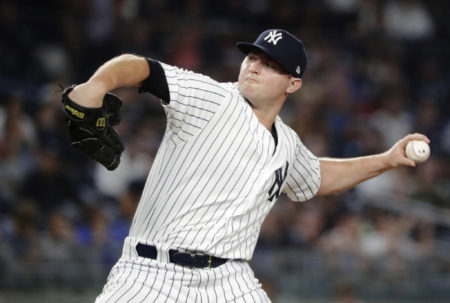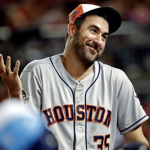State of Pitching (Part II): The Rise of the ‘Opener’
![]()
Part II of a three-part series (see Part I)
What Happened to Innovation in Baseball?
As we saw in the first part of this essay, the pitcher role has been evolving in the past five years. We saw that, in 1904, what some call the end of the pre-relief phase of baseball, 88 percent of games were complete games. But, with the elevation of innovative new managers like John McGraw and Clark Griffith in 1905, pitching strategy changed. One reason why the numbers for complete games diminished over the coming decades.
It was in 1905 that John McGraw used Claude Elliott as a relief specialist. Elliott appeared in relief eight times in 10 games, recording six saves. And so it began. But other teams did not rush to copy the New York Giants. Not for a long time. And as was discussed in the first section, Firpo Marberry would not appear for another 19 years, and even then, no team created their own Marberry weapon for another 26 years after that. So, change comes painfully slow to baseball.
Even though relief pitchers were used for more than 100 innings periodically between the 1960s and 1980s, relief pitching appearances and the average number of batters faced (BF/G) declined from 7.23 batters in 1982 to 4.37 in 2011.
But there were exceptions.
In the 1982 season, Boston pitcher Bob Stanley appeared in relief in 48 games and threw 168.1 innings, the fourth most innings pitched on the team, even though he never started a game. Add to that he recorded 16 saves.
Also in 1982, Bruce Sutter of the St. Louis Cardinals threw 122.2 innings with a 1.54 ERA and 45 saves, in what was his best season. Whereas, Lee Smith who had his best season in 1991, threw only 73 innings in 67 games. His other numbers were 47 saves with a 2.34 ERA. Excellent numbers, less innings.
Then there was the aberration represented by the work of Ramiro Mendoza of the Yankees championship teams of the late 1990s. He even saved a few games for the Yankees over those years, but his value those seasons was that Joe Torre brought Mendoza into games whenever it was necessary. And he was an effective weapon, throwing more than 100 innings four of his six seasons with the Yankees.
Since the mid-1980s, relief pitchers have not thrown more than 100 innings often, as though baseball had legislated that no reliever could throw more than 100 innings in a season. But MLB has not instituted any new pitching limitations. So, what’s happened to the 100+ inning relievers? Why aren’t there any?
Hmm.
Dave Cameron wrote an insightful essay in Fan Graphs (January 27, 2012), called Are Teams Benefiting from Relievers Pitching Less. He argued that rigidly defined relief pitching roles have not resulted in a “ . . . tangible improvement in performance.” Further advocating that, “At some point, someone is going to get back to using relievers the way they were used 30 years ago.”
Why Isn’t Baseball Weaponizing the Bullpen?
A few years ago, Terry Francona began brazenly calling upon Andrew Miller, whom the Cleveland Indians acquired from the Yankees at the trade deadline in July 2016, to pitch in innings other than the ninth. Francona felt that if the game was on the line in the fourth or fifth inning, there was no reason to wait. So, he walked out to the mound and summoned Miller. Yet the most innings Miller threw after switching to relief in 2012 for Boston were the 74.1 innings in 2016. But his effect was uncanny. And Cleveland won most of those games. Francona’s experiment was successful. But did he pave the way for other teams to follow?
Though some have, few relievers are throwing 100+ innings. And few teams chose to maximize their best reliever’s effectiveness and increase their team’s chance of winning more games. Despite Francona’s lead. Why, is unclear.
Chris Devenski of the Astros pitched more than 100 innings in 2016, but not since. Articles written about Devenski two years ago referred to him as a weapon for the Astros and suggested other teams will naturally copy the Astros.
Not.
The Tampa Bay Rays, home of the openers, began using their pitchers in a radical way during the 2018 season. For the most part, Tampa Bay relief pitchers threw the more conventional 60 to 80 inning seasons, even if they “opened.” But two of their pitchers threw more than 100 innings in combined starter/reliever roles.
Tyler Glasnow appeared in 45 games, made 11 starts and threw 111.2 innings with a 4.27 ERA (splitting time between Pittsburgh and Tampa Bay).
Ryan Yarbrough appeared in 38 games, made six starts and threw 147.1 innings with a 3.91 ERA.
Tampa Bay used different relievers whenever they were called for, and their nominal closer, Sergio Romo, saved 25 games in the 73 he appeared in, starting five times. Closers usually do not start. Except in Tampa Bay?
There were a few other combo pitchers out there. Seth Lugo of the New York Mets appeared in 54 games, made five starts, threw 101.1 innings with a 2.66 ERA. Carlos Martinez of the St. Louis Cardinals, primarily a starter, but was injured and used in relief as well. His numbers for 2018 were: 33 games, 18 starts, and he threw 118.2 innings with a 3.11 ERA. Brad Keller of the Kansas City Royals appeared in 41 games, made 20 starts, and threw 140.1 innings with a 3.08 ERA.
There may have been a few other pitchers unmentioned here, starters who relieved in a few games and the like, but above are the pitchers who relieved and came into games in the early innings, and started as well.
Not many pitchers on the list. So the legacies of Firpo Marberry and Jim Konstanty are still waiting to be fulfilled.
This past baseball season, teams like Tampa Bay, Oakland and a few others looked the other way. Rather than finding weapons to use in their bullpens, they looked for weapons to start games. They reached into their bullpens for openers to enter the game in the first inning. And to many teams surprise, those pitchers threw well enough to propel Tampa Bay (a team that almost made the playoffs) and Oakland (a team that did make the playoffs) into contention, throwing the pitching game into disarray.
This begs questions like, do teams need five starters anymore? Can they find openers for 32 or 64 games a year? Is their bullpen deep enough to open so many games? Should they carry an extra pitcher who can throw two to four innings twice a week, rather than a starter who can only throw five or six innings once a week? Or position players?
Who’s more valuable? A pitcher who can impact one game? Or two out of every seven games? For the players, given these new changes, their chief concern is value. How will teams compensate these new roles?
As is clear in other professions. Value equates to money. So, if openers become the tool to start more games, then a requisite revaluation of those pitchers management selects to open may be necessary.
Obviously openers would not be paid as legitimate aces like Clayton Kershaw or Chris Sale, but nor would they be compensated as middle relievers either. Then again, if openers catch on, than perhaps the value of fourth and fifth starters will drop dramatically.
So, a pitcher like Zach Britton, the ex-closer of the Baltimore Orioles, now with the Yankees (and a free agent this offseason), who has not been paid like a starter (although he was a starter briefly for Baltimore before they moved him to the bullpen), could be used as an opener. Or, he could be used the way Andrew Miller was by the Indians—brought in in any inning, and deployed as a weapon rather than simply as a closer. And if he were to throw 120-150 quality innings in a season, what would his value be? If a team management views him not in the traditional role of closer or the new manifestation of an opener, but as a pitcher who can be deployed whenever his team is in trouble, regardless of the inning, he could see his value rise if his win probability statistics prove that when he enters a game, his team’s chances of winning increase.
Dramatically.
In Part III, we conclude our discussion of the opener trend.
























